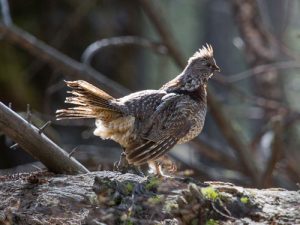The latest Wisconsin Department of Natural Resources Roadside Ruffed Grouse Drumming Survey indicated an increase in activity during the 2024 breeding season.
The survey measured ruffed grouse drumming activity heard along roadsides throughout Wisconsin this spring and showed a 57% increase in statewide drumming activity compared to 2023.
Several agencies and groups, including the DNR, U.S. Forest Service, tribal partners and volunteers, collected the data via roadside surveys of breeding grouse.
“The late spring and summer of 2023 were abnormally dry, which resulted in prime nesting and brooding conditions for ruffed grouse. This is likely the most influential factor explaining the increase in the number of drumming grouse this year,” said Alaina Roth, DNR ruffed grouse specialist. “We are also likely entering the ‘up’ phase of our 10-year population cycle, which may be an influencing factor, too.”
Ruffed grouse typically follow a 10-year population cycle, with peaks occurring in years that end in 0, 1 or 9. The surveys indicate ruffed grouse in Wisconsin are starting to enter the more populous phase of the abundance cycle. The next peak is anticipated to occur in 2029, 2030 or 2031.
Data is not available for 2020, so it is unknown whether 2019 or 2020 was the high point in the cycle, but drumming numbers appeared to wane in the years immediately following 2020.
Since 2021, survey data has been organized and analyzed by ruffed grouse priority areas to help monitor key populations across the state, as defined in the Wisconsin Ruffed Grouse Management Plan 2020-2030.
The 2024 survey results for priority areas compared to 2023 showed:
- A 41% increase in drumming in the Central priority area
- A 60% increase in drumming in the Northern priority area
- A 56% decrease in drumming in the Driftless priority area
For complete survey results, visit the DNR’s Wisconsin Wildlife Reports webpage.
Ruffed Grouse Facts
Ruffed grouse are the most widely distributed nonmigratory game bird in North America. They can be found in nearly all Canadian provinces and in 38 of the 49 continental United States.
The ruffed grouse (Bonasa umbellus) is one of four grouse species native to Wisconsin and one of 10 grouse species native to North America.
The ruffed grouse is one of the smallest of the native grouse species. Adult grouse are larger than quail but without the long tail of a pheasant. Individuals usually weigh approximately 1 to 1.5 pounds.
Ruffed grouse belong to the family of birds that includes turkeys, pheasants, chickens, quail, and partridge.
Ruffed grouse are considered a habitat specialist because of their strong reliance upon young forest habitat throughout their range.
Ruffed grouse are often associated with areas where periodic timber harvesting, fire, or natural disturbances produce verse forest habitats.
A short-lived species, ruffed grouse have with high reproductive rates which contributes to their success. ruffed grouse perform mating displays, typically taking place from early April through May in Wisconsin, starting earlier in southern Wisconsin.
Ruffed grouse rely on an entirely non-vocal display known as drumming. The distinctive sound is produced when male ruffed grouse beat their wings, creating a low frequency sound that starts in a slow, rhythmic pattern that rapidly speeds up.
Grouse drumming is audible to humans, even in thick cover, as far as a quarter-mile or more away.
Ruffed grouse are one of the most popular and widely distributed game birds in Wisconsin. Wisconsin consistently ranks as a top state for ruffed grouse harvest, along with Minnesota and Michigan.
On average, over 90,000 hunters participate in ruffed grouse hunts in Wisconsin. Each fall, hunters harvest more than 340,000 ruffed grouse in the state.
source: Wisconsin Department of Natural Resources
